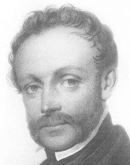

Ludwig Persius
*15. 2. 1803 – Potsdam, Germany
†12. 7. 1845 – Potsdam, Germany
Biography
Friedrich Ludwig Persius was a Prussian architect, a student and collaborator of Karl Friedrich Schinkel, with whom he assisted in the realization of the Charlottenhof Palace and the Roman Baths in the Sanssouci Park in Potsdam, where he also contributed to the construction of the Great Fountain, the Orangerie, and the observation tower on Ruinenberg hill.
His father was the Potsdam merchant Christian Friedrich Persius (1743-1811) and his mother was Marie Regina Koch. Persius attended the municipal school and gymnasium in Potsdam. From 1817 to 1819, he was an employee of building inspector Gotthilf Hecker and simultaneously trained as a carpenter. In 1819, he began studying surveying at the Building Academy in Berlin and passed his final exams in March 1821. From 1821, he worked as a building surveyor in Potsdam, among others under the guidance of Karl Friedrich Schinkel on the construction of a palace and church on the estate of Count Potocki near Krakow. In 1824, he became a member of the Association of Berlin Architects. Under Schinkel's guidance, he participated in the construction of Glienicke Palace in Berlin. In 1826, he passed the master builder examination at the Bauakademie in Berlin and became a builder in Charlottenhof. In 1827, Persius married Paulina Sello (1808-83), the sister of Hermann Ludwig Sello from the famous gardening family Sello. This marriage produced two daughters and four sons.
In 1829, he was appointed as the building inspector of the royal government in Potsdam. In 1833, he built his first independent structure: he converted a historical mill (near the Roman Baths) into a residential house for gardener Handmann. In 1834, he became the royal court building inspector. In 1840, he traveled along the banks of the Rhine. In 1841, he traveled to Paris, and also visited Munich, Strasbourg, and Cologne. In the same year, the Prussian King Frederick William IV appointed him as his court architect. In 1842, he became a royal building councilor and a member of the supreme building directorate. From 1843 to 1844, he also worked for Prince Hermann von Pückler-Muskau (known to the Czech audience as a traveler and writer under the pseudonym Semilasso). From 1843 to 1845, he again traveled through the Rhineland, Holland, France, and Italy.
He died at the young age of 42 and is buried in the family cemetery of the Hermann Sella Foundation in the Potsdam district of Bornstedt.
Friedrich Ludwig Persius was a Prussian architect, a student and collaborator of Karl Friedrich Schinkel, with whom he assisted in the realization of the Charlottenhof Palace and the Roman Baths in the Sanssouci Park in Potsdam, where he also contributed to the construction of the Great Fountain, the Orangerie, and the observation tower on Ruinenberg hill.
His father was the Potsdam merchant Christian Friedrich Persius (1743-1811) and his mother was Marie Regina Koch. Persius attended the municipal school and gymnasium in Potsdam. From 1817 to 1819, he was an employee of building inspector Gotthilf Hecker and simultaneously trained as a carpenter. In 1819, he began studying surveying at the Building Academy in Berlin and passed his final exams in March 1821. From 1821, he worked as a building surveyor in Potsdam, among others under the guidance of Karl Friedrich Schinkel on the construction of a palace and church on the estate of Count Potocki near Krakow. In 1824, he became a member of the Association of Berlin Architects. Under Schinkel's guidance, he participated in the construction of Glienicke Palace in Berlin. In 1826, he passed the master builder examination at the Bauakademie in Berlin and became a builder in Charlottenhof. In 1827, Persius married Paulina Sello (1808-83), the sister of Hermann Ludwig Sello from the famous gardening family Sello. This marriage produced two daughters and four sons.
In 1829, he was appointed as the building inspector of the royal government in Potsdam. In 1833, he built his first independent structure: he converted a historical mill (near the Roman Baths) into a residential house for gardener Handmann. In 1834, he became the royal court building inspector. In 1840, he traveled along the banks of the Rhine. In 1841, he traveled to Paris, and also visited Munich, Strasbourg, and Cologne. In the same year, the Prussian King Frederick William IV appointed him as his court architect. In 1842, he became a royal building councilor and a member of the supreme building directorate. From 1843 to 1844, he also worked for Prince Hermann von Pückler-Muskau (known to the Czech audience as a traveler and writer under the pseudonym Semilasso). From 1843 to 1845, he again traveled through the Rhineland, Holland, France, and Italy.
He died at the young age of 42 and is buried in the family cemetery of the Hermann Sella Foundation in the Potsdam district of Bornstedt.
The English translation is powered by AI tool. Switch to Czech to view the original text source.






